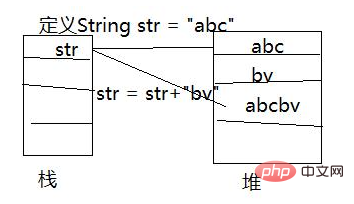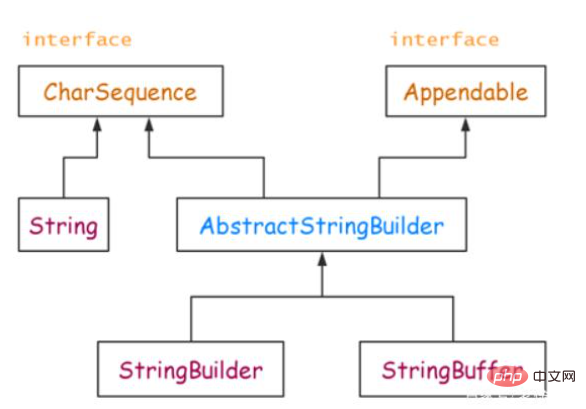The difference between string, stringbuffer and stringbuilder

What are the differences between string, stringbuffer and stringbuilder?
In a phone interview, the editor was asked whether StringBuilder is thread-safe. It's safe to blurt out, but people question me if you have 2 years of development experience. Not using this class for a long time caused me to forget my choice. It can also be said that the foundation is not strong. I don’t know if any of you have had such an experience, so I’d better record it in writing to enhance my memory.
String: Everyone knows that String is modified with final, so its value is immutable. This results in a new String object being generated every time an operation is performed on String. This is not only inefficient, but also a large number of Waste of limited memory space, as shown in the figure:

We can see that the initial String value is "abc", and then add a new string after this string " bv", this process requires re-opening memory space in the stack memory. Finally, the "abcbv" string needs to be opened up memory space accordingly. Such short two strings need to open up memory space three times. I have to say that this is a huge waste of memory space. In order to deal with frequent string-related operations, two new classes—StringBuffer class and StringBuild class—were introduced to handle such changing strings.

StringBuilder class: proposed in Java 5, characterized by mutable strings. High execution efficiency and thread unsafe.
StringBuffer class: characterized by variable strings, low execution efficiency, and thread safety.
It can be seen that the time is faster.
Summary:
If you want to operate a small amount of data, use String;
Multi-threaded operation string buffer operation A large amount of data StringBuffer;
Single-threaded operation string buffer to operate a large amount of data StringBuilder.
Recommended tutorial: "java tutorial"
The above is the detailed content of The difference between string, stringbuffer and stringbuilder. For more information, please follow other related articles on the PHP Chinese website!

Hot AI Tools

Undresser.AI Undress
AI-powered app for creating realistic nude photos

AI Clothes Remover
Online AI tool for removing clothes from photos.

Undress AI Tool
Undress images for free

Clothoff.io
AI clothes remover

AI Hentai Generator
Generate AI Hentai for free.

Hot Article

Hot Tools

Notepad++7.3.1
Easy-to-use and free code editor

SublimeText3 Chinese version
Chinese version, very easy to use

Zend Studio 13.0.1
Powerful PHP integrated development environment

Dreamweaver CS6
Visual web development tools

SublimeText3 Mac version
God-level code editing software (SublimeText3)

Hot Topics
 1385
1385
 52
52
 Convert basic data types to strings using Java's String.valueOf() function
Jul 24, 2023 pm 07:55 PM
Convert basic data types to strings using Java's String.valueOf() function
Jul 24, 2023 pm 07:55 PM
Convert basic data types to strings using Java's String.valueOf() function In Java development, when we need to convert basic data types to strings, a common method is to use the valueOf() function of the String class. This function can accept parameters of basic data types and return the corresponding string representation. In this article, we will explore how to use the String.valueOf() function for basic data type conversions and provide some code examples to
 How to convert char array to string
Jun 09, 2023 am 10:04 AM
How to convert char array to string
Jun 09, 2023 am 10:04 AM
Method of converting char array to string: It can be achieved by assignment. Use {char a[]=" abc d\0efg ";string s=a;} syntax to let the char array directly assign a value to string, and execute the code to complete the conversion.
 What are the methods to clear stringbuilder?
Oct 12, 2023 pm 04:57 PM
What are the methods to clear stringbuilder?
Oct 12, 2023 pm 04:57 PM
The methods to clear stringbuilder are: 1. Use the setLength(0) method to clear the StringBuilder object; 2. Use the delete(0, length) method to clear the StringBuilder object; 3. Use the replace(0, length, "") method to clear the StringBuilder object; 4. , Use new StringBuilder() to re-create a new StringBuilder object.
 Use the delete() method of the StringBuilder class in Java to delete part of the content in the string
Jul 26, 2023 pm 08:43 PM
Use the delete() method of the StringBuilder class in Java to delete part of the content in the string
Jul 26, 2023 pm 08:43 PM
Use the delete() method of the StringBuilder class in Java to delete part of the content in a string. The String class is a commonly used string processing class in Java. It has many commonly used methods for string operations. However, in some cases, we need to frequently modify strings, and the immutability of the String class will lead to frequent creation of new string objects, thus affecting performance. To solve this problem, Java provides the StringBuilder class, which
 Convert string to StringBuilder in Java
Sep 02, 2023 pm 03:57 PM
Convert string to StringBuilder in Java
Sep 02, 2023 pm 03:57 PM
The append() method of StringBuilder class accepts a String value and adds it to the current object. Convert string value to StringBuilder object - Get string value. Append using the append() method to get the string into the StringBuilder. Example In the following Java program, we are converting an array of strings into a single StringBuilder object. Real-time demonstration publicclassStringToStringBuilder{ publicstaticvoidmain(Stringargs[]){&a
 Use Java's String.replace() function to replace characters (strings) in a string
Jul 25, 2023 pm 05:16 PM
Use Java's String.replace() function to replace characters (strings) in a string
Jul 25, 2023 pm 05:16 PM
Replace characters (strings) in a string using Java's String.replace() function In Java, strings are immutable objects, which means that once a string object is created, its value cannot be modified. However, you may encounter situations where you need to replace certain characters or strings in a string. At this time, we can use the replace() method in Java's String class to implement string replacement. The replace() method of String class has two types:
 Interpretation of Java documentation: Detailed introduction to the substring() method of the StringBuilder class
Nov 03, 2023 pm 04:31 PM
Interpretation of Java documentation: Detailed introduction to the substring() method of the StringBuilder class
Nov 03, 2023 pm 04:31 PM
Interpretation of Java documentation: Detailed introduction to the substring() method of the StringBuilder class Introduction: In Java programming, string processing is one of the most common operations. Java provides a series of classes and methods for string processing, among which the StringBuilder class is a commonly used choice for frequent string operations. In the StringBuilder class, the substring() method is a very useful method for intercepting substrings of strings. This article will
 2w words detailed explanation String, yyds
Aug 24, 2023 pm 03:56 PM
2w words detailed explanation String, yyds
Aug 24, 2023 pm 03:56 PM
Hello everyone, today I will share with you the basic knowledge of Java: String. Needless to say the importance of the String class, it can be said to be the most used class in our back-end development, so it is necessary to talk about it.




